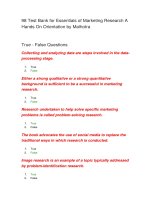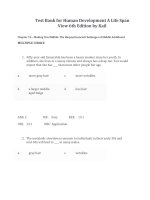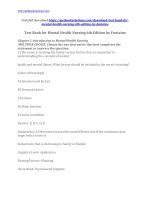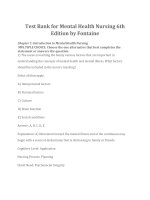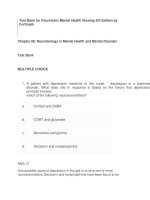Test bank for essentials of psychiatric mental health nursing 6th edition by townsend
Bạn đang xem bản rút gọn của tài liệu. Xem và tải ngay bản đầy đủ của tài liệu tại đây (191.75 KB, 12 trang )
Test Bank for Essentials of Psychiatric Mental Health Nursing 6th Edition by Townsend
Link download full: />
Sample
Chapter 11: The Recovery Model
Multiple Choice
A nursing instructor is teaching about recovery as it applies to mental illness. Which student
statement indicates that further teaching is needed?
1.
2.
3.
4.
“The goal of recovery is improved health and wellness.”
“The goal of recovery is expedient, comprehensive behavioral change.”
“The goal of recovery is the ability to live a self-directed life.”
“The goal of recovery is the ability to reach full potential.”
ANS: 2
Rationale: The Substance Abuse and Mental Health Services Administration (SAMHSA) defines
recovery from mental health disorders and substance use disorders as a process of change
through which individuals improve their health and wellness, live a self-directed life, and strive
to reach their full potential. Change in recovery is not an expedient process. It occurs
incrementally over time.
Cognitive Level: Application
Integrated Process: Evaluation
2. Which situation presents an example of the basic concept of a recovery model?
3. The client’s family is encouraged to make decisions in order to facilitate discharge.
4. A social worker, discovering the client’s income, changes the client’s discharge
placement.
5. A psychiatrist prescribes an antipsychotic drug based on observed symptoms.
6. A client diagnosed with schizophrenia schedules follow-up appointments and group
therapy.
ANS: 4
Rationale: The basic concept of a recovery model is empowerment of the consumer. The
recovery model is designed to allow consumers primary control over decisions about their own
care.
Cognitive Level: Analysis
Integrated Process: Evaluation
3. A nursing instructor is teaching about the guiding principles of the recovery model, as
described by the SAMHSA. Which student statement indicates that further teaching is
needed?
4. “Recovery occurs via many pathways.”
5. “Recovery emerges from strong religious affiliations.”
6. “Recovery is supported by peers and allies.”
7. “Recovery is culturally based and influenced.”
ANS: 2
Rationale: SAMHSA lists the following as guiding principles for the recovery model: recovery
emerges from hope, recovery is person-driven, recovery occurs via many pathways, recovery is
holistic, recovery is supported by peers and allies, recovery is supported through relationship and
social networks, recovery is culturally based and influenced, recovery is supported by addressing
trauma, recovery involves individual, family, and community strengths and responsibility,
recovery is based on respect. Recovery emerges from hope but affiliation with any particular
religion would have little bearing on the recovery process.
Cognitive Level: Application
Integrated Process: Evaluation
4. A client diagnosed with alcohol abuse disorder is referred to a residential care facility
after discharge. According to the SAMHSA, which dimension of recovery is supporting
this client?
5. Health
6. Home
7. Purpose
8. Community
ANS: 2
Rationale: SAMHSA describes the dimension of Home as a stable and safe place to live.
Cognitive Level: Application
Integrated Process: Assessment
5. A client diagnosed with obsessive-compulsive disorder states, “I really think my future
will improve because of my successful treatment choices. I’m going to make my life
better.” Which guiding principle of recovery has assisted this client?
6. Recovery emerges from hope.
7. Recovery is person-driven.
8. Recovery occurs via many pathways.
9. Recovery is holistic.
ANS: 1
Rationale: The SAMHSA lists the following as guiding principles for the recovery model:
recovery emerges from hope, recovery is person-driven, recovery occurs via many pathways,
recovery is holistic, recovery is supported by peers and allies, recovery is supported through
relationship and social networks, recovery is culturally based and influenced, recovery is
supported by addressing trauma, recovery involves individual, family, and community strengths
and responsibility, recovery is based on respect. This client has internalized hope. This hope is
the catalyst of the recovery process.
Cognitive Level: Application
Integrated Process: Evaluation
6. A nurse maintains a client’s confidentiality, addressed the client appropriately, and does
not discriminate based on gender, age, race, or religion. Which guiding principle of
recovery has this nurse employed?
7. Recovery is culturally based and influenced.
8. Recovery is based on respect.
9. Recovery involves individual, family, and community strengths and responsibility.
10. Recovery is person-driven.
ANS: 2
Rationale: The SAMHSA lists the following as guiding principles for the recovery model:
recovery emerges from hope, recovery is person-driven, recovery occurs via many pathways,
recovery is holistic, recovery is supported by peers and allies, recovery is supported through
relationship and social networks, recovery is culturally based and influenced, recovery is
supported by addressing trauma, recovery involves individual, family, and community strengths
and responsibility, recovery is based on respect. This nurse accepts and appreciates clients who
are affected by mental health and substance use problems. This nurse protects the rights of
clients and does not discriminate against them.
Cognitive Level: Application
Integrated Process: Implementation
7. A nurse on an inpatient unit helps a client understand the significance of treatments, and
provides the client with copies of all documents related to the plan of care. This nurse is
employing which commitment in the “Tidal Model of Recovery?”
8. Know that Change Is Constant
9. Reveal Personal Wisdom
10. Be Transparent
11. Give the Gift of Time
ANS: 3
Rationale: Barker & Buchanan-Barker developed a set of essential values termed the The 10
Tidal Commitments upon which the Tidal Model is based. They include: Value the Voice,
Respect the Language, Develop Genuine Curiosity, Become the Apprentice, Use the Available
Toolkit, Craft the Step Beyond, Give the Gift of Time, Reveal Personal Wisdom, Know that
Change Is Constant, and Be Transparent. This nurse is employing the Be Transparent
commitment.
Cognitive Level: Application
Integrated Process: Implementation
8. Which is the priority focus of recovery models?
9. Empowerment of the health-care team to bring their expertise to decision-making
10. Empowerment of the client to make decisions related to individual health care
11. Empowerment of the family system to provide supportive care
12. Empowerment of the physician to provide appropriate treatments
ANS: 2
Rationale: The basic concept of a recovery model is empowerment of the client. The recovery
model is designed to allow clients primary control over decisions about their own care.
Cognitive Level: Analysis
Integrated Process: Assessment
9. A client experiences an exacerbation of psychiatric symptoms to the point of threatening
self-harm. Which action step of the Wellness Recovery Action Plan (WRAP) model
should be employed, and what action reflects this step?
10. Step 3: Triggers that cause distress or discomfort are listed.
11. Step 4: Signs indicating relapse are identified and plans for responding are developed.
12. Step 5: A specific plan to help with symptoms is formulated.
13. Step 6: Following client-designed plan, caregivers now become decision-makers.
ANS: 4
Rationale: The WRAP recovery model is a step-wise process through which an individual is able
to monitor and manage distressing symptoms that occur in daily life. The six steps include: Step
1. Develop a Wellness Toolbox; Step 2. Daily Maintenance List; Step 3. Triggers; Step 4. Early
Warning Signs; Step 5. Things Are Breaking Down or Getting Worse; Step 6. Crisis Planning. In
step 6 (Crisis Planning) clients can no longer care for themselves, make independent decisions,
or keep themselves safe. Caregivers take an active role in this step on behalf of the client and
implement the plan that the client has previously developed. All other actions presented require
the client to be functionally capable.
Cognitive Level: Analysis
Integrated Process: Evaluation
10. A nursing instructor is teaching about components present in the recovery process as
described by Andresen and associates that led to the development of the Psychological
Recovery Model. Which student statement indicates that further teaching is needed?
11. “A client has a better chance of recovery if he or she truly believes that recovery can
occur.”
12. “If a client is willing to give the responsibility of treatment to the health-care team, they
are likely to recover.”
13. “A client who has a positive sense of self and a positive identity is likely to recover.”
14. “A client has a better chance of recovery if he or she has purpose and meaning in life.”
ANS: 2
Rationale: In examining a number of studies, Andresen and associates identified four
components that were consistently evident in the recovery process. These components are hope,
responsibility, self and identity, and meaning and purpose. Under responsibility, this model tasks
the client, not the health-care team, with taking responsibility for his or her life and well-being.
Cognitive Level: Analysis
Integrated Process: Evaluation
11. A client states, “My illness is so devastating, I feel like my life is on hold.” The nurse
recognizes that this client is in which stage of the Psychological Recovery Model as
described by Andersen and associates?
12. Moratorium
13. Awareness
14. Preparation
15. Rebuilding
ANS: 1
Rationale: Andresen and associates have conceptualized a five-stage model of recovery called
the Psychological Recovery Model. The stages include: Stage 1: Moratorium, Stage 2:
Awareness, Stage 3: Preparation, Stage 4: Rebuilding, and Stage 5: Growth. The moratorium
stage is identified by dark despair and confusion. It is called moratorium, because it seems that
“life is on hold.”
Cognitive Level: Analysis
Integrated Process: Evaluation
12. A client states, “I have come to the conclusion that this disease has not paralyzed me.”
The nurse recognizes that this client is in which stage of the Psychological Recovery
Model as described by Andersen and associates?
13. Moratorium
14. Awareness
15. Preparation
16. Rebuilding
ANS: 2
Rationale: Andresen and associates have conceptualized a five-stage model of recovery called
the Psychological Recovery Model. The stages include: Stage 1: Moratorium, Stage 2:
Awareness, Stage 3: Preparation, Stage 4: Rebuilding, and Stage 5: Growth. In the awareness
stage, the individual comes to a realization that a possibility for recovery exists. Andresen and
associates state, “It involves an awareness of a possible self other than that of ‘sick person’: a
self that is capable of recovery.”
Cognitive Level: Analysis
Integrated Process: Evaluation
13. A psychiatrist who embraces the Psychological Recovery Model tells the nurse that a
client is in the Growth stage. What should the nurse expect to fine when assessing this
client?
14. A client feeling confident about achieving goals in life.
15. A client who is aware of the need to set goals in life.
16. A client who has mobilized personal and external resources.
17. A client who begins to actively take control of his or her life.
ANS: 1
Rationale: Andresen and associates have conceptualized a five-stage model of recovery called
the Psychological Recovery Model. The stages include: Stage 1: Moratorium, Stage 2:
Awareness, Stage 3: Preparation, Stage 4: Rebuilding, and Stage 5: Growth. In the growth stage,
the individual feels a sense of optimism and hope of a rewarding future. Skills that have been
nurtured in the previous stages are applied with confidence, and the individual strives for higher
levels of well-being.
Cognitive Level: Analysis
Integrated Process: Assessment
Multiple Response
14. Which of the following has the SAMHSA described, as major dimensions of support for
a life of recovery? (Select all that apply)
15. Health
16. Community
17. Home
18. Religious affiliation
19. Purpose
ANS: 1, 2, 3, 5
Rationale: SAMHSA suggests that a life in recovery is supported by four major dimensions,
which include health, home, purpose, and community. Religious affiliation is not included in the
listed dimensions.
Cognitive Level: Application
Integrated Process: Assessment
15. A nurse uses the commitments of the Tidal Model of Recovery in psychiatric nursing
practice. Which of the following nursing actions reflect the use of the Develop Genuine
Curiosity commitment? (Select all that apply.)
16. The nurse expresses interest in the client’s story.
17. The nurse asks for clarification of certain points.
18. The nurse encourages the client to speak his own words in his own unique way.
19. The nurse assists the client to unfold the story at his or her own rate.
20. The nurse provides the clients with copies of all documents relevant to care.
ANS: 1, 2, 4
Rationale: Barker & Buchanan-Barker developed a set of essential values termed the The 10
Tidal Commitments, upon which the Tidal Model is based. They include: Value the Voice,
Respect the Language, Develop Genuine Curiosity, Become the Apprentice, Use the Available
Toolkit, Craft the Step Beyond, Give the Gift of Time, Reveal Personal Wisdom, Know that
Change Is Constant, and Be Transparent. This nurse is employing the Develop Genuine Curiosity
commitment, by expressing interest, asking for clarification, and assisting the client to unfold the
story at his or her own rate.
Cognitive Level: Application
Integrated Process: Implementation
Ordered Response
16. Order the six steps of The Wellness Recovery Action Plan(WRAP) Model as described
by Copeland et al.
17. ________ Daily Maintenance List
18. ________ Things Are Breaking Down or Getting Worse
19. ________ Crisis Planning
20. ________ Develop a Wellness Toolbox
5 _________ Early Warning Signs
6._________ Triggers
ANS: The correct order is 2, 5, 6, 1, 4, 3
Rationale: The WRAP model is a step-wise process, through which an individual is able to
monitor and manage distressing symptoms that occur in daily life. The six steps include: Step 1.
Develop a Wellness Toolbox; Step 2. Daily Maintenance List; Step 3. Triggers; Step 4. Early
Warning Signs; Step 5. Things Are Breaking Down or Getting Worse; Step 6. Crisis Planning.
Cognitive Level: Analysis
Integrated Process: Assessment
Fill-in-the-Blank
17. _________________________ from mental health disorders and substance use disorders
is a process of change through which individuals improve their health and wellness, live a
self-directed life, and strive to reach their full potential.
ANS: Recovery
Rationale: Recovery from mental health disorders and substance use disorders is a process of
change through which individuals improve their health and wellness, live a self-directed life, and
strive to reach their full potential. Recovery is the restoration to a former or better state or
condition.
Cognitive Level: Application
Integrated Process: Assessment
Essentials of Psychiatric Mental Health Nursing: 6th Edition Test Bank – Townsend
